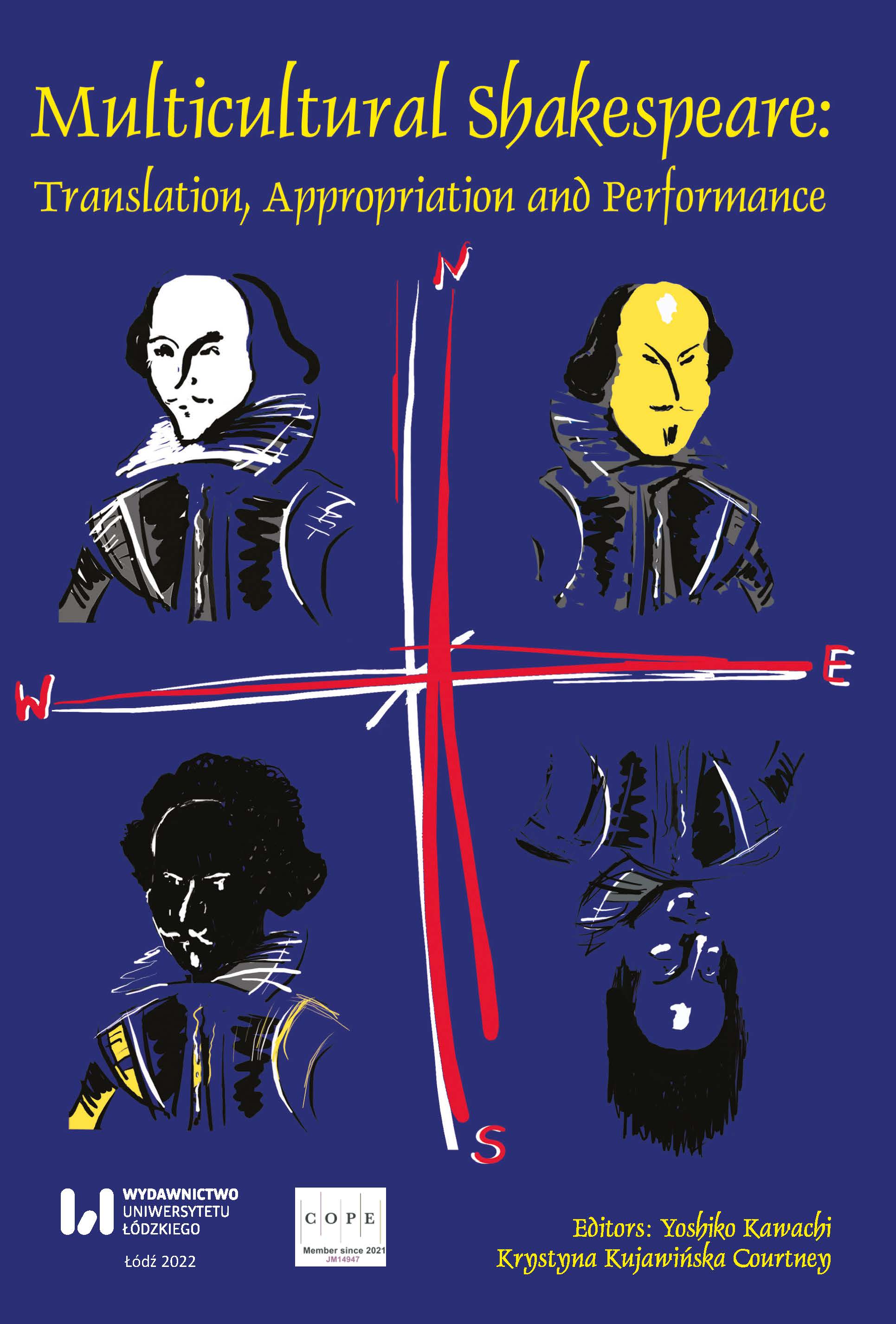“To Make Dark Heaven Light:” Transcending the Tragic in Sintang Dalisay
DOI:
https://doi.org/10.18778/2083-8530.26.03Słowa kluczowe:
Shakespeare and adaptation, Filipino reception of Shakespeare, Romeo and Juliet adaptations, genre transformation, global ShakespeareAbstrakt
Directed by Ricardo Abad and choreographed by Matthew Santamaria, Sintang Dalisay—a Filipino adaptation of Shakespeare’s Romeo & Juliet—is often lauded for its use of the igal ethnic dance of the Sama-Badjau, a Muslim tribe located in the southern region of the Philippines. It depicts Rashiddin and Jamillia’s star-crossed love amidst a violent and ancient feud between their families. This paper discusses the process and product of interweaving performance traditions and cultures in Sintang Dalisay and how the adaptation transforms Shakespeare’s Romeo and Juliet from tragic to utopic. It does so in two aspects: the kinesthetic and the mythic. First, the use of the igal dance motif expresses and unearths the play’s inherently religious and celestial language. Second, the appropriation of Asian myths or beliefs—particularly of Chinese and Filipino origins—transforms and transcends the tragic ending of Romeo and Juliet’s deaths.
Pobrania
Bibliografia
Abad, Ricardo. “The Ten Mats of Sintang Dalisay.” Perspectives in the Arts and Humanities Asia 10.1 (2002). https://journals.ateneo.edu/index.php/apah/issue/view/306/ Accessed 14 July 2022.
Google Scholar
Abad, Ricardo and MCM Santamaria. “Localizing Shakespeare as Folk Performance: Romeo and Juliet, Sintang Dalisay, and the Igal of the Sama Bajau in Southern Philippines.” Perspectives in the Arts and Humanities Asia 10.1 (2002). https://journals.ateneo.edu/index.php/apah/issue/view/306/ Accessed 14 July 2022.
Google Scholar
The Chinese legend of the butterfly lovers—Lijun Zhang. Dir. Amir Houshang Moein. Video. 2022. TED-ed. YouTube. youtube.com/watch?v=6MiOTB-Kpzw/ Accessed 9 September 2022.
Google Scholar
Dela Cerna, Julian. “The Music of Edru Abraham: An Openness in Sintang Dalisay.” Perspectives in the Arts and Humanities Asia 10.1 (2002). https://journals.ateneo.edu/index.php/apah/issue/view/306/ Accessed 14 July 2022.
Google Scholar
Demetrio, Francisco. “Death: Its Origin and Related Beliefs Among the Early Filipinos.” Philippine Studies 14.3 (1966). https://www.jstor.org/stable/42720118 Accessed 9 September 2022.
Google Scholar
Dolan, Jill. “Introduction: Feeling the Potential of Elsewhere.” Utopia in Performance: Finding Hope at the Theatre. Michigan: The University of Michigan Press, 2005. 1-34.
Google Scholar
Dyer, Richard. “Entertainment and Utopia.” Only Entertainment. 1992. London, New York: Routledge, 2002. 19-25.
Google Scholar
Fischer-Lichte, Erika. “Introduction: Interweaving Performance Cultures—Rethinking ‘Intercultural Theater’: Toward an Experience and Theory of Performance beyond Postcolonalism.” The Politics of Interweaving Performance Cultures Beyond Postcolonialism. Eds. Erika Fischer-Lichte, Torsten Jost and Saskya Iris Jain. London, New York: Routledge, 2014. 1-24.
Google Scholar
Gaverza, Karl. “The Soul According to the Ethnolinguistic Groups of the Philippines.” Aswang Project. 15 April 2017. Highbanks Entertainment Ltd. https://www.aswangproject.com/soul-according-ethnolinguistic-groups-philippines/ Accessed 9 September 2022.
Google Scholar
Hutcheon, Linda. “Beginning to Theorize Adaptation: What? Who? Why? How? Where? When?” A Theory of Adaptation. London, New York: Routledge, 2006. 1-27.
Google Scholar
Ick, Judy Celine. “And Never the Twain Shall Meet? Shakespeare and Philippine Performance Traditions.” Re-playing Shakespeare in Asia. Eds. Poonam Trivdei and Minami Ryuta. London, New York: Routledge, 2010. 181-199.
Google Scholar
Ick, Judy Celine. “The Undiscovered Country: Shakespeare in Philippine Literatures.” Kritika Kultura 21/22 (2013/2014). https://ajol.ateneo.edu/kk/articles/74/722/ Accessed 9 July 2022.
Google Scholar
Lanier, Douglas. “Shakespeare and Cultural Studies: An Overview.” Shakespeare 2.2 (2006). http://doi.org/10.1080/17450910600983893/
Google Scholar
Lei, Beatrice Bi-Qi. “Shakespeare’s Asian Journeys: Introduction.” Shakespeare’s Asian Journeys: Critical Encounters, Cultural Geographies, and the Politics of Travel. Eds. Bi-Qi Beatrice Lei, Judy Celine Ick, and Poonam Trivedi. London, New York: Routledge, 2017. 1-18.
Google Scholar
Nimmo, H. Arlo. “Religious Rituals of the Tawi-Tawi Bajau.” Philippine Studies 38.2 (1990). https://www.jstor.org/stable/42633177 Accessed 9 September 2022.
Google Scholar
Orkin, Martin. “William Tshikinya-Chaka, I presume? Cultural encounter in performance.” Local Shakespeares: Proximations and Power. London, New York: Routledge, 2005. 43-61.
Google Scholar
Santamaria, MCM. “From Tortillier to Ingsud-Ingsud: Creating New Understandings Concerning the Importance of Indigenous Dance Terminology in the Practice and Kinaesthetics of the Sama Igal Dance Tradition.” Asian Studies: Journal of Critical Perspectives on Asia 49:2 (2013). https://asj.upd.edu.ph/mediabox/archive/ASJ-49-2-2013/Santamaria.pdf/ Accessed 10 July 2022.
Google Scholar
Shakespeare, William. Romeo and Juliet. Ed. René Weis. Arden Shakespeare. London: Bloomsbury, 2012.
Google Scholar
Sintang Dalisay [Pure Love]. Dir. Ricardo Abad. Video. 2011. Tanghalang Ateneo and Ateneo Fine Arts, Ateneo de Manila University. Yong Li Lan, Lim Eng Hui Alvin, Takiguchi Ken, Hwang Ha Young, Lee Chee Keng, Suematsu Michiko, Kobayashi Kaori and Lee Hyon-u. (A|S|I|A). 2.0 edition, 2016. Web. 7 February 2023.
Google Scholar
Trivdei, Poonam. “Re-playing Shakespeare in Asia: Introduction.” Re-playing Shakespeare in Asia. Eds. Poonam Trivdei and Minami Ryuta. London, New York: Routledge, 2010. 1-20.
Google Scholar
Varela-Luarca, Guelan. “Ang Sintang Dalisay bilang Tsapsuy at Halimaw ni Dr. Frankenstein: Isang Pagbabalik-tanaw ng Mandudula.” Perspectives in the Arts and Humanities Asia 10.1 (2002). https://journals.ateneo.edu/index.php/apah/issue/view/306/ Accessed 14 July 2022.
Google Scholar
Varela-Luarca, Guelan, Ricardo Abad, and MCM Santamaria. “Pure Love: Abridged performance text for seven actors and three musicians.” Perspectives in the Arts and Humanities Asia 10.1 (2002). https://journals.ateneo.edu/index.php/apah/issue/view/306/ Accessed 14 July 2022.
Google Scholar
Pobrania
Opublikowane
Wersje
- 2023-12-20 - (2)
- 2022-12-30 - (1)
Jak cytować
Numer
Dział
Licencja

Utwór dostępny jest na licencji Creative Commons Uznanie autorstwa – Użycie niekomercyjne – Bez utworów zależnych 4.0 Międzynarodowe.












